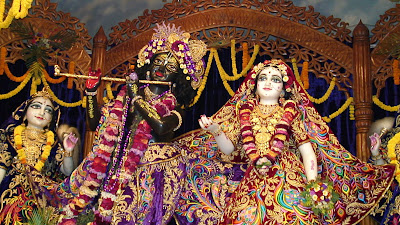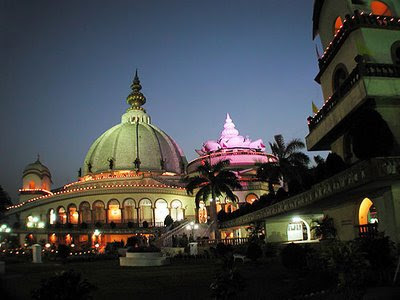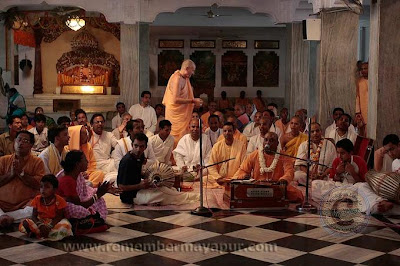I don’t believe in god…
But when friends asked me to go to Mayapur; for a day’s outing, I agreed just because of I was bored enough with my daily routine… And when I read the founder (Mr. Abhay Charan De) of the ISKCON was from my college (Scottish Church College; Kolkata) I got some interest to know him.
The journey to his place became an experience to me. I’m trying to share it now with my very little knowledge. Any discrepancies or wrong statement may please corrected. Your comments will make me aware.
The Creation of Sri Mayapur (from "The Ananta – Samhita")
Immersed in feelings of Krishna, Radha began to think. She gathered her sakhis together between the Ganges and Yamuna Rivers. She created there a beautiful place, decorated with creepers and filled bumblebees; and the whole area was filled with the fragrance of jasmine, mallika and malati. On Radha’s order, the Ganges and Yamuna with their water and banks acted as a moat to protect the garden. Radha dressed colorful, and then began to play a beautiful melody on a flute to magnetize Krishna. Attracted by that melody, Krishna appeared in that enchanting place.
Krishna spoke in a voice (choked with love); "Just for Me You have created this wonderful place. I will transform this place, filling it with new sakhis and groves. The devotees will glorify this place as Nava Vrindavan. As this place is like an island (Dvip) the wise will call it Navadvipa. By my order, all the holy places will reside here. Because you have created this place for my pleasure, I will live here eternally. O dear Radha, like Vrindavan, this place is extremely pure. If anyone comes here just once, he will obtain the results of going to all the sacred places."
Saying this, Krishna merged with Radha’s body and began to reside there eternally. At that time the vibration of "Jaya Gaurahari!" filled the four directions: From that time the devotees call this form of Krishna, Gaura-hari: As Radha is Gauri (fair) and Krishna is Hari.
The International Society for Krishna Consciousness
Abhay Charanaravinda Bhaktivedanta Swami Prabhupada (September 1, 1896 – November 14, 1977) started his Religious career from his spiritual master, Bhaktisiddhanta Sarasvati Thakura. He requested him to spread the message of Chaitanya Mahaprabhu in the English language.
Prabhupāda, means "he who has taken the position of the Lord" where prabhu denotes "Lord", and pāda means "position." Also, "at whose feet masters sit".
Prabhupada started the publication called “Back to Godhead”,
He translated over sixty volumes of classic Vedic scriptures (such as the Bhagavad Gita and the Srimad Bhagavatam) into the English language.
In his first magazine he wrote:
“Under the circumstances since 1936 up to now, I was simply speculating whether I shall venture this difficult task and that without any means and capacity; but as none have discouraged me, I have now taken courage to take up the work.”
He started his journey (like all other religious heros) to spread the "Godhead is Light, Nescience is darkness".
But his journey begins from USA in 1965 (I don’t understand why..??)… In his own narration “I do not know why You have brought me here. Now You can do whatever You like with me. But I guess You have some business here, otherwise why would You bring me to this terrible place? How will I make them understand this message of Krishna consciousness? I am very unfortunate, unqualified and most fallen. Therefore I am seeking Your benediction so that I can convince them, for I am powerless to do so on my own.”
ISKCON, also known as the Hare Krishna movement, is a Hindu Gaudiya Vaishnava religious organization. It was founded in 1966 in New York City by Swami Prabhupada. Its core beliefs are based on traditional Hindu scriptures such as the Śrīmad Bhāgavatam and the Bhagavad-gītā, according to the traditional Hindu view, date back more than 5,000 years. The distinctive appearance of the movement and its culture come from the Gaudiya Vaishnava tradition, which has had adherents in India since the late 15th century and Western converts since the early 1930s.
ISKCON was formed to spread the practice of Bhakti Yoga (devotion to God), in which aspirant devotees dedicate their thoughts and actions towards pleasing the Supreme Lord, Krishna.
ISKCON devotees follow a line of Gaudiya Bhagavata Vaishnavas and are the largest branch of Gaudiya Vaishnavism. Vaishnavism means 'worship of Vishnu', and Gauḍa refers to the area where this particular branch of Vaishnavism originated, in the Gauda region of West Bengal. Gaudiya Vaishnavism has had a following in India, especially West Bengal and Orissa, for the past five hundred years. A.C. Bhaktivedanta Swami Prabhupada distributed Gaudiya Vaishnava Theology in the Western world through his writings and translations, including the Bhagavad Gita, Srimad Bhagavatam (Bhagavata Purana), Chaitanya Charitamrita and other scriptures.
The Maha Mantra is:
“Hare Krishna Hare Krishna
Krishna Krishna Hare Hare
Hare Rama Hare Rama
Rama Rama Hare Hare”
Following the establishment of temples and centers in the United States and Europe, he returned to India in 1971, holding many public programs which were well attended. From 1971 onwards, the movement became increasingly popular and spread throughout the country, He was particularly eager to see the progress at "the impressive temple project in" Mumbai which he and his disciples had fought very hard to establish, with large temples in Mayapur and Vrindavan to follow in mid 1970s.
.
When Srila Prabhupada first incorporated ISKCON in 1966, he gave it seven purposes:
1. To systematically propagate spiritual knowledge to society at large and to educate all people in the techniques of spiritual life in order to check the imbalance of values in life and to achieve real unity and peace in the world.
2. To propagate a consciousness of Krishna, as it is revealed in the Bhagavad-gita and the Srimad-Bhagavatam.
3. To bring the members of the Society together with each other and nearer to Krishna, the prime entity, thus to develop the idea within the members, and humanity at large, that each soul is part and parcel of the quality of Godhead (Krishna).
4. To teach and encourage the sankirtana movement, congregational chanting of the holy names of God as revealed in the teachings of Lord Sri Chaitanya Mahaprabhu.
5. To erect for the members, and for society at large, a holy place of transcendental pastimes, dedicated to the personality of Krishna.
6. To bring the members closer together for the purpose of teaching a simpler and more natural way of life.
7. With a view towards achieving the aforementioned purposes, to publish and distribute periodicals, magazines, books and other writings.
The four legs of Dharma he mentioned are:
1. Daya: Mercy
2. Tapas: Self-Control or Austerity
3. Satyam: Truthfulness
4. Śaucam: Cleanliness of body and mind
But when I heard about the allegation of brainwashing to minors or about the abusing case to the children or pseudo prostitute business inside it; I don’t feel good…
End of the day I conclude, it solidifies my belief again…… Yes till now I don’t believe in GOD…
But when friends asked me to go to Mayapur; for a day’s outing, I agreed just because of I was bored enough with my daily routine… And when I read the founder (Mr. Abhay Charan De) of the ISKCON was from my college (Scottish Church College; Kolkata) I got some interest to know him.
The journey to his place became an experience to me. I’m trying to share it now with my very little knowledge. Any discrepancies or wrong statement may please corrected. Your comments will make me aware.
The Creation of Sri Mayapur (from "The Ananta – Samhita")
Immersed in feelings of Krishna, Radha began to think. She gathered her sakhis together between the Ganges and Yamuna Rivers. She created there a beautiful place, decorated with creepers and filled bumblebees; and the whole area was filled with the fragrance of jasmine, mallika and malati. On Radha’s order, the Ganges and Yamuna with their water and banks acted as a moat to protect the garden. Radha dressed colorful, and then began to play a beautiful melody on a flute to magnetize Krishna. Attracted by that melody, Krishna appeared in that enchanting place.
Krishna spoke in a voice (choked with love); "Just for Me You have created this wonderful place. I will transform this place, filling it with new sakhis and groves. The devotees will glorify this place as Nava Vrindavan. As this place is like an island (Dvip) the wise will call it Navadvipa. By my order, all the holy places will reside here. Because you have created this place for my pleasure, I will live here eternally. O dear Radha, like Vrindavan, this place is extremely pure. If anyone comes here just once, he will obtain the results of going to all the sacred places."
Saying this, Krishna merged with Radha’s body and began to reside there eternally. At that time the vibration of "Jaya Gaurahari!" filled the four directions: From that time the devotees call this form of Krishna, Gaura-hari: As Radha is Gauri (fair) and Krishna is Hari.
The International Society for Krishna Consciousness
Abhay Charanaravinda Bhaktivedanta Swami Prabhupada (September 1, 1896 – November 14, 1977) started his Religious career from his spiritual master, Bhaktisiddhanta Sarasvati Thakura. He requested him to spread the message of Chaitanya Mahaprabhu in the English language.
Prabhupāda, means "he who has taken the position of the Lord" where prabhu denotes "Lord", and pāda means "position." Also, "at whose feet masters sit".
Prabhupada started the publication called “Back to Godhead”,
He translated over sixty volumes of classic Vedic scriptures (such as the Bhagavad Gita and the Srimad Bhagavatam) into the English language.
In his first magazine he wrote:
“Under the circumstances since 1936 up to now, I was simply speculating whether I shall venture this difficult task and that without any means and capacity; but as none have discouraged me, I have now taken courage to take up the work.”
He started his journey (like all other religious heros) to spread the "Godhead is Light, Nescience is darkness".
But his journey begins from USA in 1965 (I don’t understand why..??)… In his own narration “I do not know why You have brought me here. Now You can do whatever You like with me. But I guess You have some business here, otherwise why would You bring me to this terrible place? How will I make them understand this message of Krishna consciousness? I am very unfortunate, unqualified and most fallen. Therefore I am seeking Your benediction so that I can convince them, for I am powerless to do so on my own.”
ISKCON, also known as the Hare Krishna movement, is a Hindu Gaudiya Vaishnava religious organization. It was founded in 1966 in New York City by Swami Prabhupada. Its core beliefs are based on traditional Hindu scriptures such as the Śrīmad Bhāgavatam and the Bhagavad-gītā, according to the traditional Hindu view, date back more than 5,000 years. The distinctive appearance of the movement and its culture come from the Gaudiya Vaishnava tradition, which has had adherents in India since the late 15th century and Western converts since the early 1930s.
ISKCON was formed to spread the practice of Bhakti Yoga (devotion to God), in which aspirant devotees dedicate their thoughts and actions towards pleasing the Supreme Lord, Krishna.
ISKCON devotees follow a line of Gaudiya Bhagavata Vaishnavas and are the largest branch of Gaudiya Vaishnavism. Vaishnavism means 'worship of Vishnu', and Gauḍa refers to the area where this particular branch of Vaishnavism originated, in the Gauda region of West Bengal. Gaudiya Vaishnavism has had a following in India, especially West Bengal and Orissa, for the past five hundred years. A.C. Bhaktivedanta Swami Prabhupada distributed Gaudiya Vaishnava Theology in the Western world through his writings and translations, including the Bhagavad Gita, Srimad Bhagavatam (Bhagavata Purana), Chaitanya Charitamrita and other scriptures.
The Maha Mantra is:
“Hare Krishna Hare Krishna
Krishna Krishna Hare Hare
Hare Rama Hare Rama
Rama Rama Hare Hare”
Following the establishment of temples and centers in the United States and Europe, he returned to India in 1971, holding many public programs which were well attended. From 1971 onwards, the movement became increasingly popular and spread throughout the country, He was particularly eager to see the progress at "the impressive temple project in" Mumbai which he and his disciples had fought very hard to establish, with large temples in Mayapur and Vrindavan to follow in mid 1970s.
.
When Srila Prabhupada first incorporated ISKCON in 1966, he gave it seven purposes:
1. To systematically propagate spiritual knowledge to society at large and to educate all people in the techniques of spiritual life in order to check the imbalance of values in life and to achieve real unity and peace in the world.
2. To propagate a consciousness of Krishna, as it is revealed in the Bhagavad-gita and the Srimad-Bhagavatam.
3. To bring the members of the Society together with each other and nearer to Krishna, the prime entity, thus to develop the idea within the members, and humanity at large, that each soul is part and parcel of the quality of Godhead (Krishna).
4. To teach and encourage the sankirtana movement, congregational chanting of the holy names of God as revealed in the teachings of Lord Sri Chaitanya Mahaprabhu.
5. To erect for the members, and for society at large, a holy place of transcendental pastimes, dedicated to the personality of Krishna.
6. To bring the members closer together for the purpose of teaching a simpler and more natural way of life.
7. With a view towards achieving the aforementioned purposes, to publish and distribute periodicals, magazines, books and other writings.
The four legs of Dharma he mentioned are:
1. Daya: Mercy
2. Tapas: Self-Control or Austerity
3. Satyam: Truthfulness
4. Śaucam: Cleanliness of body and mind
But when I heard about the allegation of brainwashing to minors or about the abusing case to the children or pseudo prostitute business inside it; I don’t feel good…
End of the day I conclude, it solidifies my belief again…… Yes till now I don’t believe in GOD…






1 comment:
An interestimg and thoughtful spritual journey!
Thanks for sharing. :)
Post a Comment